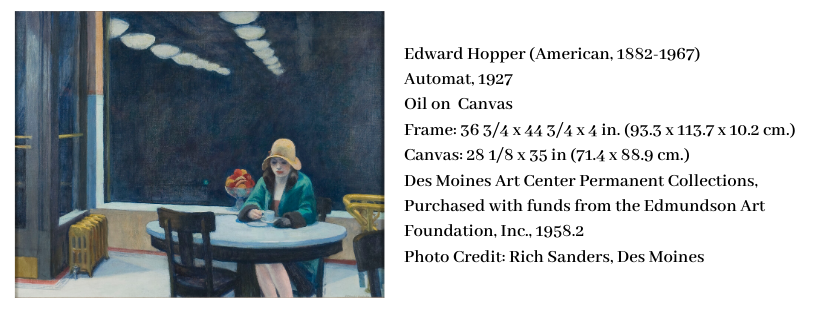TDS 47 The Automat By Hopper, An Iconic Scene of Social Distancing, The Des Moines Art Center
Edward Hopper (American, 1882-1967), Automat, 1927, Oil on canvas Frame: 36 3/4 × 44 3/4 × 4 in. (93.3 × 113.7 × 10.2 cm.) Canvas: 28 1/8 × 35 in. (71.4 × 88.9 cm.) Des Moines Art Center Permanent Collections; Purchased with funds from the Edmundson Art Foundation, Inc., 1958.2 Photo Credit: Rich Sanders, Des Moines
Interview with Des Moines Art Center’s Curator Laura Burkhalter
These days, a bit of Edward Hopper seems to speak volumes. The American painter is best known for depicting stark night scenes with people set apart from each other in solitude.
Social distancing aside, take note and take heart for a treat. This week on The Delicious Story, you’ll meet curator Laura Burkhalter of The Des Moines Art Center and enjoy an audio tour of one of Hopper’s most celebrated paintings, The Automat.
A WALK INSIDE THE PAINTING
David and I are privileged to be close neighbors with The Des Moines Art Center, an internationally recognized gallery housing a signature collection of contemporary art from the 19th century to modern times. And the fact that our small Midwestern city is home to this institution started with an interesting history.
It was also an interesting story that led me to obtain this fascinating interview in the first place. (The graciousness of the The Art Center staff played a big part, too.)
Several weeks ago, before the pandemic and social distancing became our way of life, I reached out to The Art Center and asked to interview someone about artworks in the permanent collection that featured food in some way.
I was thrilled with their reply. Not only would I be speaking with the Center’s curator, but we would focus together on a Hopper painting that has forever been one of the most popular pieces in their collection.
In this interview, Burkhalter walks you into the world of The Automat. You become acquainted with the subject and her story—the mysterious woman wearing a hat and one glove set in 1927. The space where she sits is quiet, and she is alone. We ponder questions and consider possible answers to her ambiguous state in the picture.
The dichotomy of the scene is our subject’s place in her world. She is in a sense isolated, perhaps because of the time of day and her job. And that she is alone in an urban area heightens the contrast of her quarantine in a normally-busy public venue. Loneliness is a strange byproduct of crowded spaces. The scene resonates.
EATING ALONE HOPPER-STYLE
I previously thought that the automat restaurant (popular from the 1920s through the 1960s) was a purely American invention. However, the concept actually originated in Europe in the late 1800s and made its way here after the turn of the century.
The format of the operation was that customers withdrew prepared dishes from behind little glass doors. The setup was a fast-food style eatery for working people eager to grab a quick lunch. The popularity of these restaurants grew quickly in the U.S., particularly in urban areas as industrialization picked up during the 20th century.
The story of the Automat’s rise and eventual decline make for an interesting read over at ThoughtCo in the article, “The Rise and Fall of the Automat: Or, Whatever Happened to Horn & Hardart?” Or maybe you’re more familiar with automats based on a scene from the Doris Day movie of 1957 titled, “A Touch of Mink.”
A quick bite and eating alone remain components of fast food restaurants today, which came along after the automat’s heyday. Our lives often lend to picking up food to consume as fuel more than a culinary respite. And ironically, because we still view eating as a social activity, eating alone in public is an uncomfortable option for many of us. (Hello, eating in the car!)
THE BACKSTORY AT THE DES MOINES ART CENTER
Burkhalter also takes us behind the scenes at The Des Moines Art Center, providing details as to how they curate and share the collection of thousands of pieces of art. In addition, the Des Moines Art Center offers a series of scheduled touring exhibits each year.
Burkhalter explains the importance of the word “Center” in the institution’s title, and how the focus manifests in their work and mission. I’ll give you a clue that it has a great deal to do with their robust educational arm.
The Des Moines Art Center is an AAM-accredited institution known for its important collection of major works of modern art. Other works include Jasper John’s Tennyson, Henri Matisse’s Woman in White, Georgia O’Keeffe’s From the Lake No. 1, and Francis Bacon’s Study After Valásquez’s Portrait of Pope Innocent X, among many others.
Nearly 75 years old, The Des Moines Art Center remains true to their goal to provide people access to important contemporary art—with free admission.
Other on-sight attractions which draw the public on a daily basis include a popular gift shop offering distinctive artisan and boutique items for purchase, as well as ongoing art courses for people of all ages, plus special tours and lectures.
The Center’s facility is a pleasing composite of three distinct buildings featuring the architectural designs of Eliel Saarinen, I.M. Pei, and Richard Meier connected strategically to allow for the open courtyard which reveals the designs from a distinctive vantage.
DINING AT THE DES MOINES ART CENTER
Lunch at the Des Moines Art Center restaurant is a lure for the public as well. Patrons enjoy the culinary talents of the catering firm Tangerine, who opened their first restaurant at the Art Center in 2019. Menu items include soups, salads, sandwiches and other dishes made especially for the diners of The Des Moines Art Center.
Dining for lunch is a pleasure during the Center’s hours for both the delicious food and the beautiful atmosphere. Tangerine is nestled in an intimate and charming space in the facility, and during the warmer months customers bask in the beautiful setting of the open courtyard as well.
And for those who seek a sweet repast, desserts are featured on the menu meant to delight patrons who want an enticing break before revisiting the galleries.
WE’LL ALL MEET AGAIN!
In this historic time of keeping our distance, I wonder how we will feel about our society’s issue with isolation and loneliness in the future. I know there is plenty I took for granted, about public spaces and the wonderful amenities such as The Des Moines Art Center before this interview. But I’m taking stock and making plans. Friends and acquaintances, look out!
In the meantime, as we strive to stay healthy, slowing down the pace and appreciating our cultural heritage from the comfort of home isn’t all bad. We are reminded in the great works of art that we are part of a rich human story. And when we do return to being in closer proximity to each other, we can remember how un-alone we truly are.
Sherry and Alexandra Borzo together in Lima, Peru
Sherry is the founder of Storied Gifts a personal publishing service of family and company histories. She and her team help clients curate and craft their stories into books. When not writing or interviewing, Sherry spends loads of time with her grandchildren and lives in Des Moines, Iowa.
STORIED GIFTS SHOP
Need a beautiful infusion of inspiration for your storied life? Please check out the Storied Gifts Shop where we offer Wearable Wisdom & Daily Inspirations.
The shop is a mother and daughter venture for Sherry and Alexandra Borzo of Content In Motion. They both work to help their client's stories sing. The shop is their effort to inspire a focus on healthy minds for everyone through positive thought.
LET’S BE FRIENDS
Please like the Storied Gifts Facebook page. We offer tips and inspirations to help you tell your stories and live a storied life by harnessing your healthy mind through the power of the thoughts you choose.













